Spatiotemporal Variation and Circulation Characteristics of Extreme Maximum Temperature Events in East China (1961–2020)
Abstract
:1. Introduction
2. Materials and Methods
2.1. Study Area
2.2. Data Sources
2.3. Identification of Extreme Maximum Temperature Events (EMTEs)
2.4. Analysis Methods
3. Results
3.1. Variations in the Annual Number of EMTE Days
3.1.1. Temporal Variations
3.1.2. Spatial Variations
3.2. Variations in EMTE Intensity
3.3. Variations in the Maximum Consecutive EMTE Days
3.4. Variations in the First and Last EMTE Days
4. Relationship between EMTEs and Atmospheric Circulation
5. Discussion and Conclusions
- (1)
- Within the past 60 years, the annual number of EMTE days in East China increased at a substantial rate, passing the t-test at a significance level of 0.05. The number of days increased by 1.45 d/decade. The numbers of EMTE days in the 1970s and 1990s were remarkably lower than the normal year means, but then increased considerably in the 21st century. In comparison with the normal year means, the EMTE days changed from relatively low to substantially higher at the beginning of the 21st century, showing abrupt change points. The mutation of EMTE days occurred in 2009, and the growth rate before and after the mutation was 0.4 and 2.8 d/10a, respectively.
- (2)
- Over the 60-year study period, the number of EMTE days exhibited an increasing trend in eastern, southern, and coastal areas of East China, while a weak decreasing trend was observed in northern and western areas. The number of days increased most prominently at a rate of up to 3–6 d/decade (locally 6–9 d/decade) in eastern areas of the Yangtze River Delta, coastal areas of Zhejiang and Fujian, and southern Jiangxi Province, all of which passed the t-test at a significance level of 0.05.
- (3)
- The EMTE intensity showed an increasing trend at a rate of 0.15 °C/decade in East China during the 60-year study period, passing the t-test at a significance level of 0.05. The linear variation trends of the extreme maximum temperature were between −0.2 and 0.8 °C/decade, with a distinct upward trend in most areas. Historical maximum-temperature extremes occurred primarily in 2003 and 2013.
- (4)
- The mean number of consecutive EMTE days increased by 0.24 d/10a in East China, an increase of 1.4 d in the recent 60 years. The growth rate increased significantly after 2003, i.e., the mean number of consecutive EMTE days during 2003–2020 increased by 35% in comparison with that in 1961–2002. The mean number of consecutive EMTE days in the south was greater than that in the north, and the annual variation trend was between −1.3 and 2.1 d/10a. The growth rate in the Yangtze River Delta, eastern coastal areas, and southern mountainous areas passed the t-test at a significance level of 0.05. The mean mutation time was 2003, and the growth rate before and after the mutation was 0.4 and 1.4 d/10a, respectively.
- (5)
- In the past 60 years in East China, the mean first EMTE day gradually advanced and the mean last EMTE day became delayed, especially in the 21st century. Over the study period, the mean first EMTE day advanced by 12 days and the mean last EMTE day became delayed by 7 days; the mean first EMTE day had a mutation in 2000 and the mean last EMTE day had a mutation in 2015.
- (6)
- In East China, EMTEs are clearly related to the intensity and location of the subtropical high, western Pacific Subtropical high, South Asian high, and mid-latitude westerly trough. Extreme summer high temperatures occur in East China because the study region experiences atmospheric subsidence resulting from the intensification and westward extension of the subtropical high coupled with the weakening and northward displacement of the mid-latitude westerly trough.
Author Contributions
Funding
Institutional Review Board Statement
Informed Consent Statement
Data Availability Statement
Acknowledgments
Conflicts of Interest
References
- IPCC. Climate Change 2021: The Physical Science Basis; Masson-Delmotte, V., Zhai, P., Pirani, A., Connors, S.L., Péan, C., Berger, S., Caud, N., Chen, Y., Goldfarb, L., Gomis, M.I., et al., Eds.; Contribution of Working Group Ι to the Sixth Assessment Report of the Intergovernmental Panel on Climate Change; Cambridge University Press: Cambridge, UK; New York, NY, USA, 2021. [Google Scholar]
- Ferrelli, F.; Brendel, A.S.; Perillo, G. Warming signals emerging from the analysis of daily changes in extreme temperature events over Pampas (Argentina). Environ. Earth Sci. 2021, 80, 1–13. [Google Scholar] [CrossRef]
- Vincent, L.A.; Mekis, É. Changes in Daily and Extreme Temperature and Precipitation Indices for Canada over the Twentieth Century. Atmos. Ocean. 2006, 44, 177–193. [Google Scholar] [CrossRef] [Green Version]
- Chao, L.; Huang, B.; Yuanjian, Y.; Jones, P.; Cheng, J.; Yang, Y.; Li, Q. A new evaluation of the role of urbanization to warming at various spatial scales: Evidence from the Guangdong-Hong Kong-Macau region, China. Geophys. Res. Lett. 2020, 47, e2020GL089152. [Google Scholar] [CrossRef]
- Shen, X.; Liu, B.; Jiang, M.; Lu, X. Marshland loss warms local land surface temperature in China. Geophys. Res. Lett. 2020, 47, e2020GL087648. [Google Scholar] [CrossRef] [Green Version]
- Feng, Y.; Li, G. Interaction between urbanization and eco-environment in the Tibetan Plateau. J. Geogr. Sci. 2021, 31, 298–324. [Google Scholar] [CrossRef]
- Ding, Y.; Ren, G. Climate Change Science in China; China Meteorological Press: Beijing, China, 2008; p. 281. [Google Scholar]
- Yang, X.; Ruby Leung, L.; Zhao, N.; Zhao, C.; Qian, Y.; Hu, K.; Chen, B. Contribution of urbanization to the increase of extreme heat events in an urban agglomeration in east China. Geophys. Res. Lett. 2017, 44, 6940–6950. [Google Scholar] [CrossRef]
- Shi, J.; Wei, P.P.; Cui, L.; Zhang, B. Spatio-temporal characteristics of extreme precipitation in East China from 1961 to 2015. Meteorol. Z. 2018, 27, 377–390. [Google Scholar] [CrossRef]
- Shi, J.; Wen, K.; Cui, L. Distribution and trend on consecutive days of severe weathers in China during 1959–2014. J. Geogr. Sci. 2016, 26, 658–672. [Google Scholar] [CrossRef] [Green Version]
- Shi, J.; Ding, Y.H.; Cui, L.L. Climatic characteristics and causes of extreme high temperature in East China. Atmos. Sci. 2009, 33, 347–358. [Google Scholar]
- Wang, Q.; Zhang, M.J.; Wang, S.J. Analysis of extreme temperature events in the Yangtze River Basin from 1962 to 2011. J. Geogr. 2013, 68, 611–625. [Google Scholar]
- Ju, L.L.; Shi, J.; Zhang, M. Extreme temperature changes over East China from 1961 to 2015. Desert Oasis Meteorol. 2020, 14, 112–121. [Google Scholar]
- Mao, Y.W.; Chen, Z.H.; Chen, Q.; Xie, P. Characteristics of extreme temperature indices in Wuhan from 1951 to 2016. Desert Oasis Meteorol. 2018, 12, 75–82. [Google Scholar]
- Zhu, X.; Ye, C.; Peng, J.; Cai, H.C. Variation characteristics of extreme temperature events in Hunan Province from 1960 to 2014. Desert Oasis Meteorol. 2016, 10, 82–89. [Google Scholar]
- Wu, L.; Chen, L.; Wang, K.; Ma, J. Temporal and Spatial Variation Characteristics of Annual Extreme Temperature in the Mainland of China During 1983–2012. J. Arid. Meteorol. 2016, 34, 945–951. [Google Scholar]
- Liang, M.; Wu, L. Characteristics analysis of Extreme High Temperature in Summer in Eastern China. Meteorol. Sci. 2015, 35, 701–709. [Google Scholar]
- Chen, Y.; Zhang, L.; Qian, H. Variation characteristics and regional differences of extreme high temperature days in South China during the last 53 years. Trop. Geography 2016, 36, 692–699. [Google Scholar]
- Ding, H.J.; Zhou, L.L.; Zha, B.; Zhai, G.Q. Analysis of abnormal high temperature in Summer 2003 in Jiangnan. J. Zhejiang Univ. Nat. Sci. 2007, 1, 100–105. [Google Scholar]
- Zeng, X.; Zhai, J.; Su, B.; Jiang, T.; Zhu, J. Temporal and spatial variation of annual mean temperature in the Yangtze River Basin. Resour. Environ. Yangtze Basin 2009, 18, 427–431. [Google Scholar]
- Zhang, S.; Yin, Z.; Liu, Y.; Wen, J.H.; Zhang, H.; An, Y.Z. Risk analysis of high temperature disaster in East China based on GIS. Disaster 2011, 26, 59–65. [Google Scholar]
- Dong, B.; Sutton, R.T.; Chen, W.; Liu, X.; Lu, R.; Sun, Y. Abrupt Summer Warming and Changes in Temperature Extremes over Northeast Asia Since the Mid-1990s: Drivers and Physical Processes. Adv. Atmos. Sci. 2016, 33, 1005–1023. [Google Scholar] [CrossRef] [Green Version]
- Shi, J.; Cui, L.; Wen, K.; Tian, Z.; Wei, P.; Zhang, B. Trends in the consecutive days of temperature and precipitation extremes in China during 1961–2015. Environ. Res. 2018, 161, 381–391. [Google Scholar] [CrossRef] [PubMed]
- Hu, K.; Huang, G.; Wu, R. A Strengthened Influence of ENSO on August High Temperature Extremes over the Southern Yangtze River Valley since the Late 1980s. J. Clim. 2013, 26, 2205–2221. [Google Scholar] [CrossRef] [Green Version]
- Ai-Hui, W.; Jian-Jian, F.U. Changes in Daily Climate Extremes of Observed Temperature and Precipitation in China. Atmos. Ocean. Sci. Lett. 2013, 6, 89–96. [Google Scholar] [CrossRef]
- Vincent, L.A.; Aguilar, E.; Saindou, M.; Hassane, A.F.; Jumaux, G.; Roy, D. Observed trends in indices of daily and extreme temperature and precipitation for the countries of the western Indian Ocean, 1961–2008. J. Geophys. Res. 2011, 116, D10. [Google Scholar] [CrossRef]
- Guan, Y.; Zhang, X.; Zheng, F.; Wang, B. Trends and variability of daily temperature extremes during 1960–2012 in the Yangtze River Basin, China. Int. J. Climatol. 2015, 124, 79–94. [Google Scholar] [CrossRef] [Green Version]
- Niu, Z.; Wang, L.; Fang, L.; Li, J.; Yao, R. Analysis of spatiotemporal variability in temperature extremes in the Yellow and Yangtze River basins during 1961–2014 based on high-density gauge observations. Int. J. Climatol. 2020, 40, 1–21. [Google Scholar] [CrossRef]
- Zhang, S.Y.; Wang, S.R.; Zhang, Y.S.; Zhang, D.K.; Song, Y.L. The climatic character of high temperature and the prediction in the large cities of east of China. J. Tropical Meteor. 2004, 20, 750–760. [Google Scholar]
- Plackett R, L. Studies in the History of Probability and Statistics. XXIX: The Discovery of the Method of Least Squares. Biometrika 1972, 59, 239–251. [Google Scholar] [CrossRef]
- Milliken, G.A.; Bates, D.M.; Watts, D.G. Nonlinear Regression Analysis and Its Applications. Technometrics 1988, 32, 219. [Google Scholar] [CrossRef]
- Wu, J.; Wu, J.; Huang, W.; Yao, L.N.; Lei, Z.C. Variation characteristics of Extreme temperature in East China in recent 50 years. Hubei Agric. Sci. 2020, 60, 96–100, 114. [Google Scholar]
- Lei, Y.; Gong, D.; Zhang, Z.; Guo, D.; He, X.Y. Temporal and spatial variation of summer high temperature days and their circulation background in China. Geogr. Res. 2009, 28, 653–662. [Google Scholar]
- Yin, J.; J, M.; Xiao, A.; Zhang, Y. Characteristics and Forecasting methods of Subtropical high during Summer High Temperature in Jiangxi province. Meteorol. Disaster Reduct. Res. 2011, 34, 19–25. [Google Scholar]
- Sun, J.; Wang, H.; Yuan, W. Interdecadal Variation of Extreme High Temperature Events in China and their Relationship with Atmospheric Circulation. Clim. Environ. Res. 2011, 16, 199–208. [Google Scholar]
- Wang, W.; Xu, J.; Cai, X.; Sun, C. Analysis of atmospheric circulation characteristics and mechanism of heat wave and drought in summer of 2013 over the middle and lower reaches of Yangtze River Basin. Plateau Meteorol. 2017, 36, 1595–1607. [Google Scholar]
- Shi, J.; Cui, L.; Zhou, W. Analysis of atmospheric Circulation characteristics during high Temperature period in East China. J. Trop. Meteorol. 2009, 25, 753–759. [Google Scholar]
- Zou, H.; Wu, S.S.; Shan, J.S.; Wang, S. Diagnostic study of the severe high temperature event over Mid-East China in 2013 summer. Acta Meteorol. Sin. 2015, 73, 481–495. [Google Scholar]
- Li, Z.H.; Li, C.Y.; Song, J.; Tan, Y.; Li, X. An analysis of the characteristics and causes of extremely high temperature days in the Yangtze–Huaihe River basins in summer 1960–2011. Clim. Environ. Res. 2015, 20, 511–522. [Google Scholar]
- Yin, J.; Zhang, C.J.; Zhang, C.M. Clmiatic Diagnostic Analysis of the Exceptional High Temperature in Summer 2003 in Jiangxi Province. J. Nanjing Inst. Meteorol. 2005, 6, 855–861. [Google Scholar]
- Lin, X.; Guan, Z.Y. Temporal and spatial characteristics and interannual variation of summer high Temperature in East China. J. Nanjing Inst. Meteorol. 2008, 31, 1–9. [Google Scholar]
- Peng, X.; Guo, B.Y.; Wei, N.; She, Q.N.; Liu, M.; Xiang, W.N. Characteristics of extreme heat events variations and their response to urbanization in Yangtze river delta region in recent sixty years. Resour. Environ. Yangtze Basin 2016, 25, 1917–1926. [Google Scholar]
- Zhang, L.; Ren, G.Y.; Miao, S.G.; Zhang, A.Y.; Meng, F.C.; Zhu, S.C.; Ren, Y.Y.; Suo, N.K.Z. Numerical Simulation of Urbanization on a Single extreme high Temperature process in Beijing. Chin. J. Atmos. Sci. 2020, 44, 1093–1108. [Google Scholar]
- Ao, X.Y.; Tan, J.G.; Zhi, X.; Guo, Q.B.; Lu, Y.W.; Liu, D.W. Synergistic effect of urban Heat Island and heat wave in Shanghai and its influencing factors. Acta Geogr. Sin. 2019, 74, 1789–1802. [Google Scholar]
- Mitchell, J.M.J. The thermal climate of Cities. Public Health Serv. 1961, 62, 131–145. [Google Scholar]
- Oke, T.R. City size and the urban heat islands. Atmos. Environ. 1973, 7, 769–779. [Google Scholar] [CrossRef]
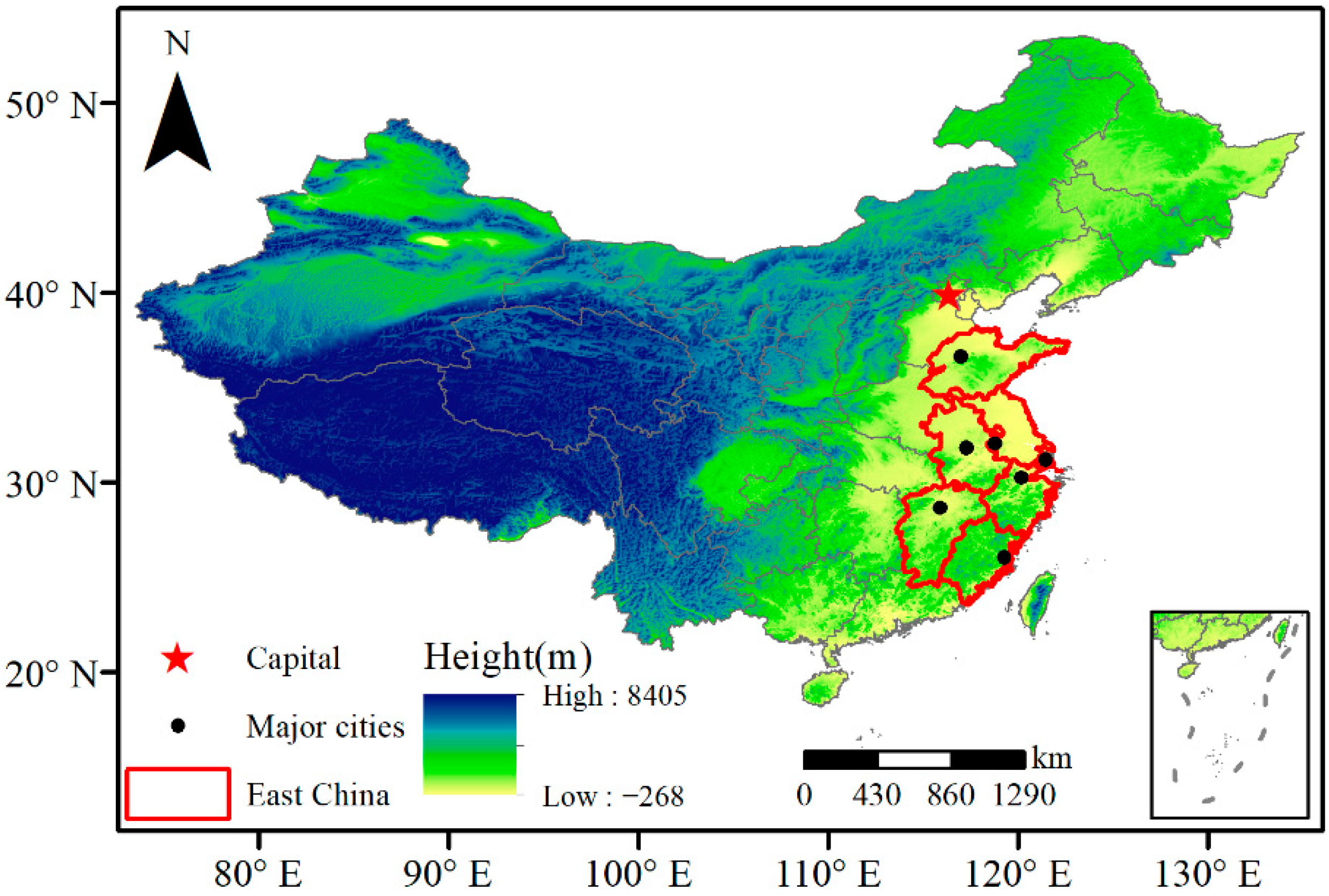

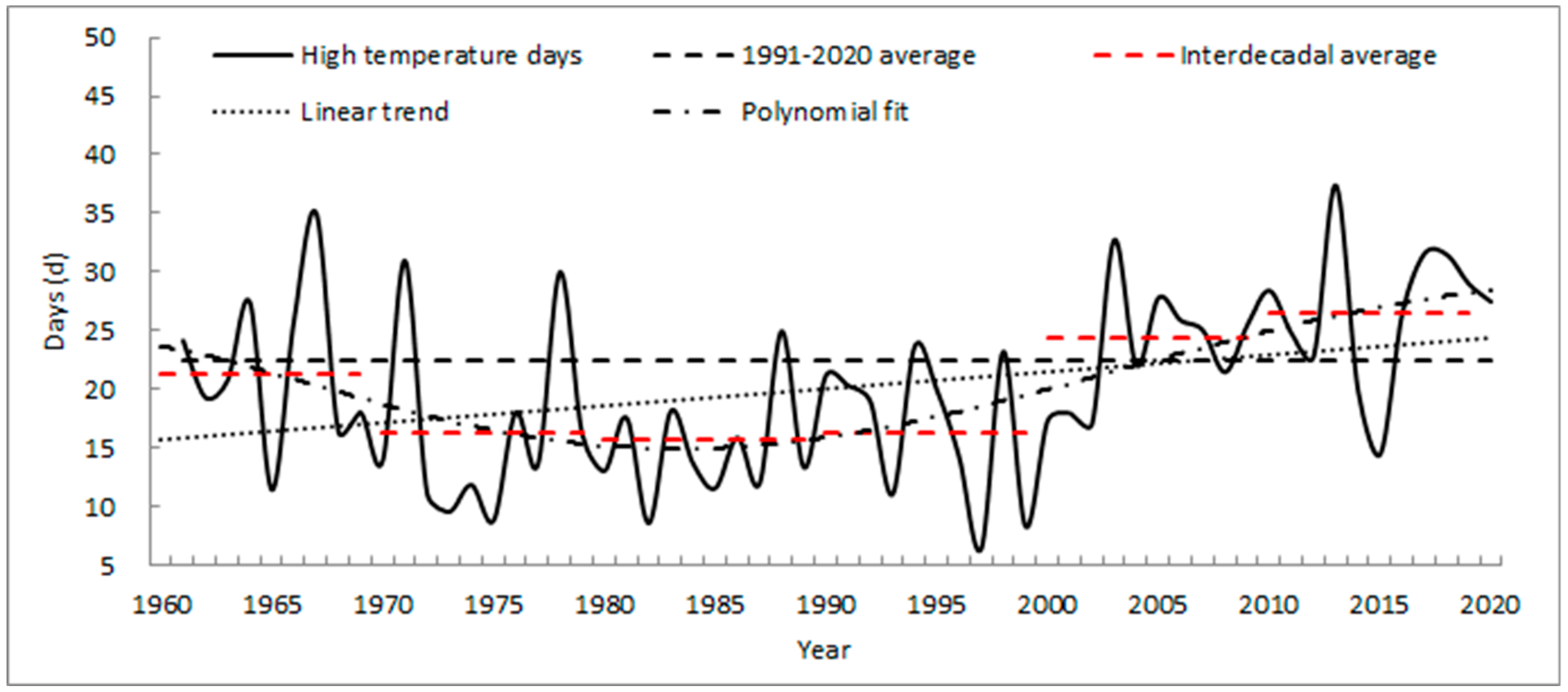

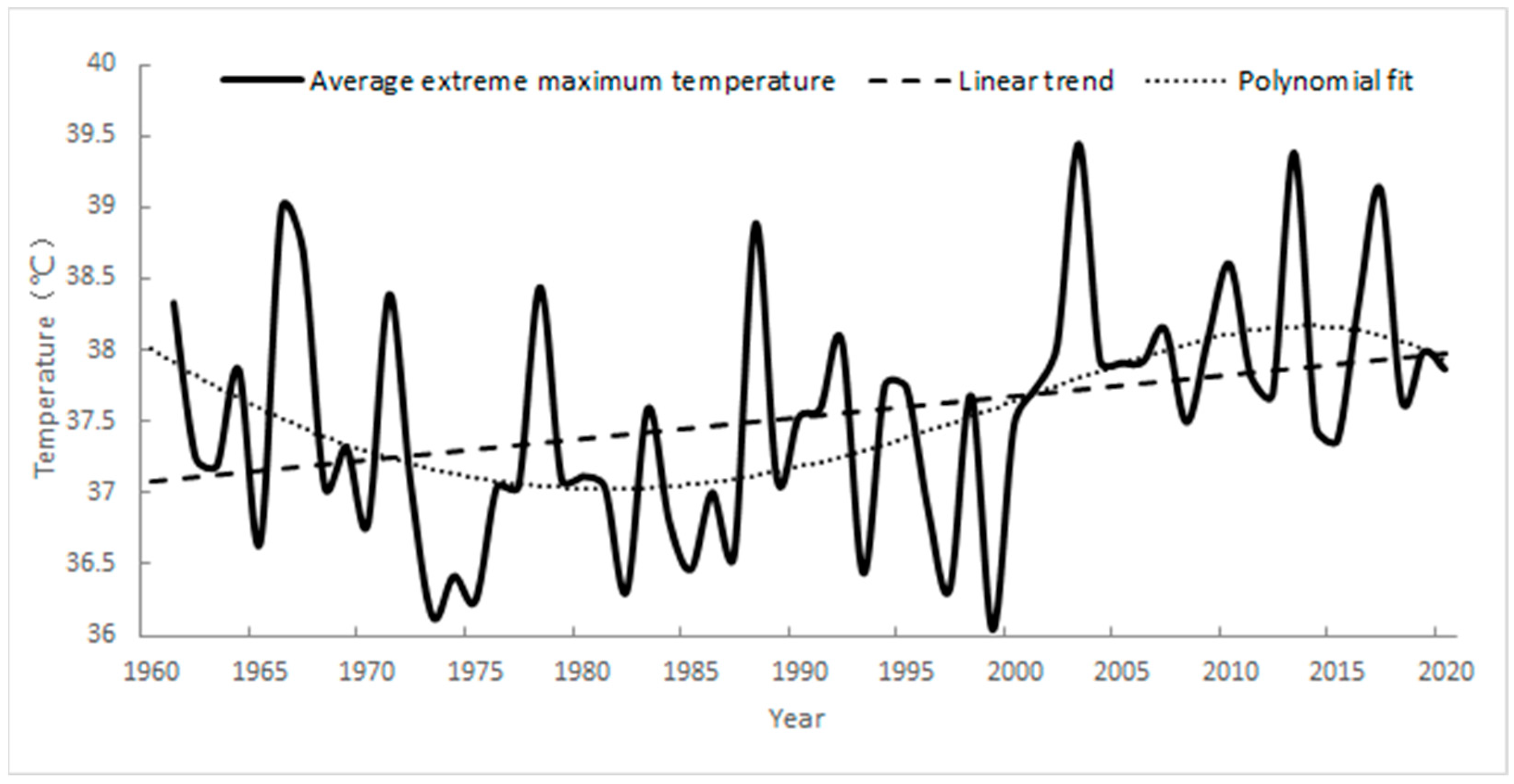
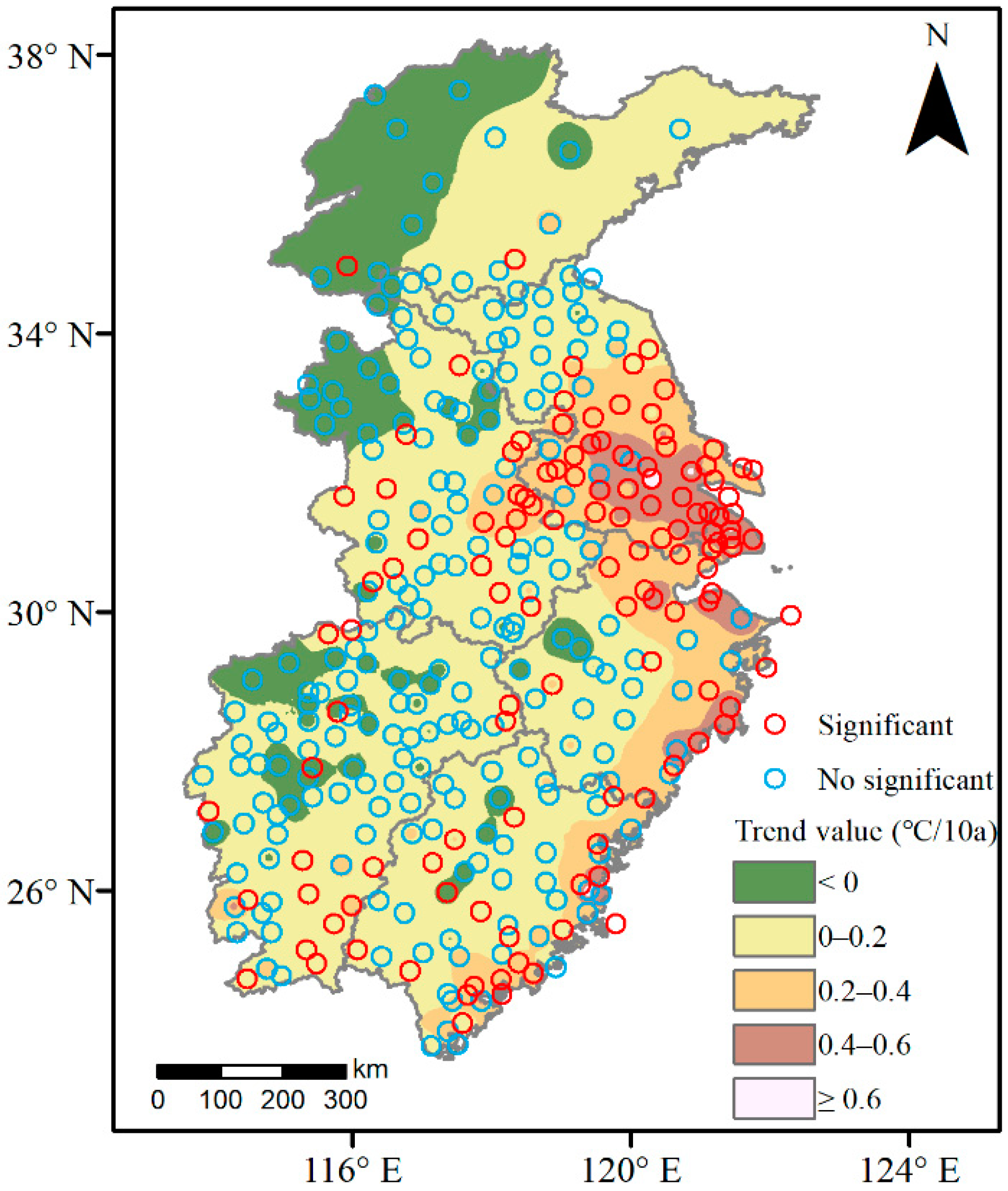

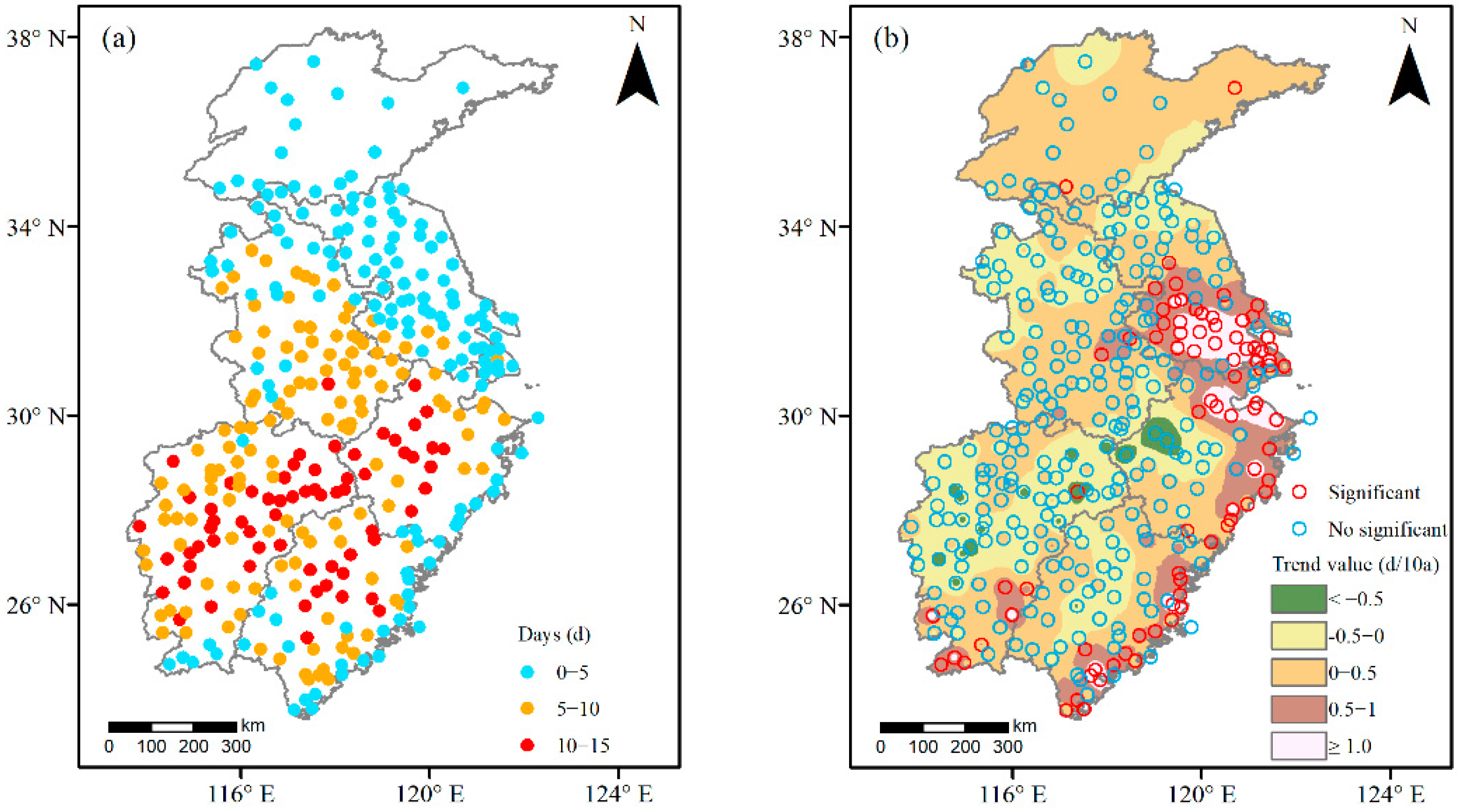
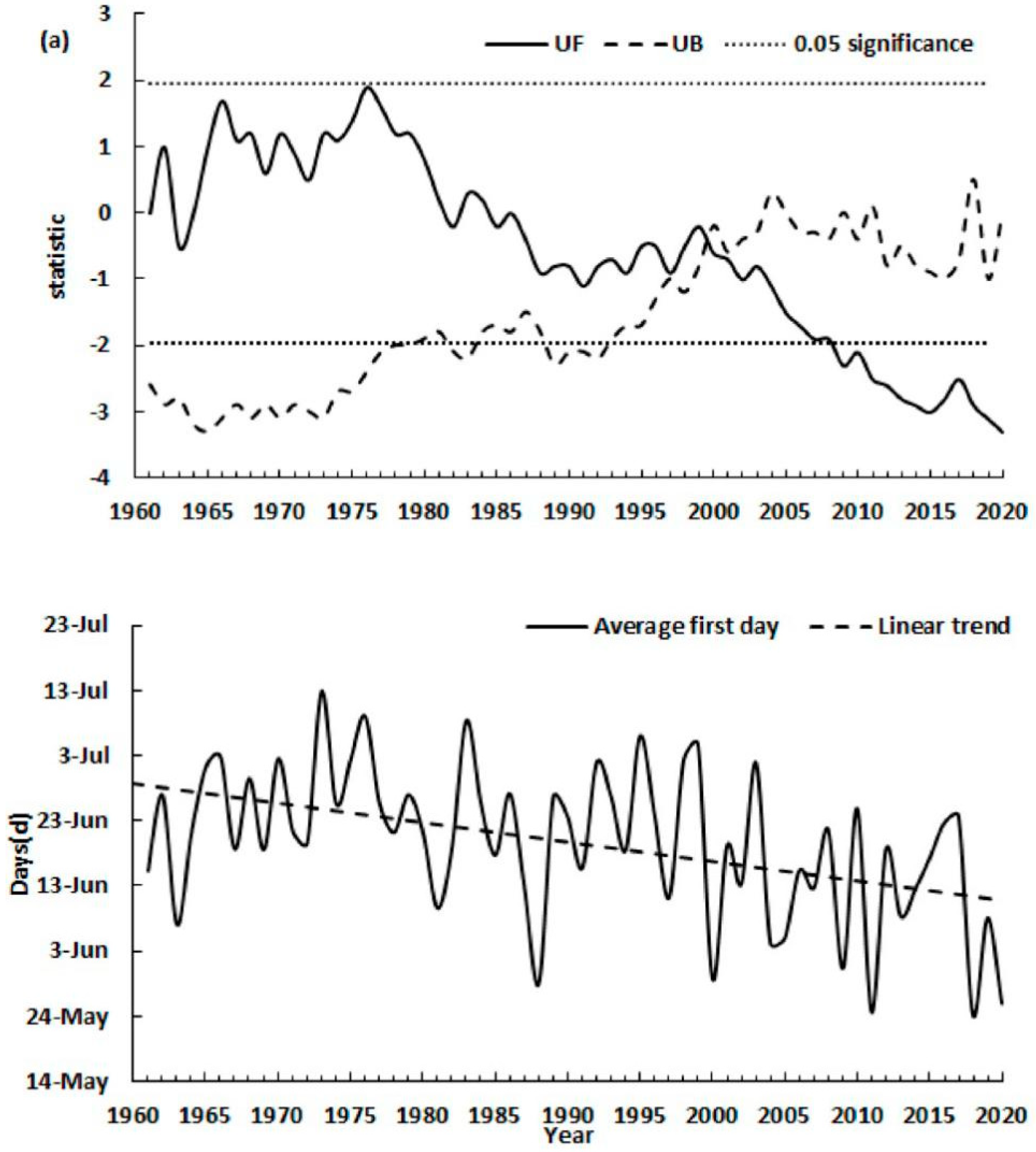



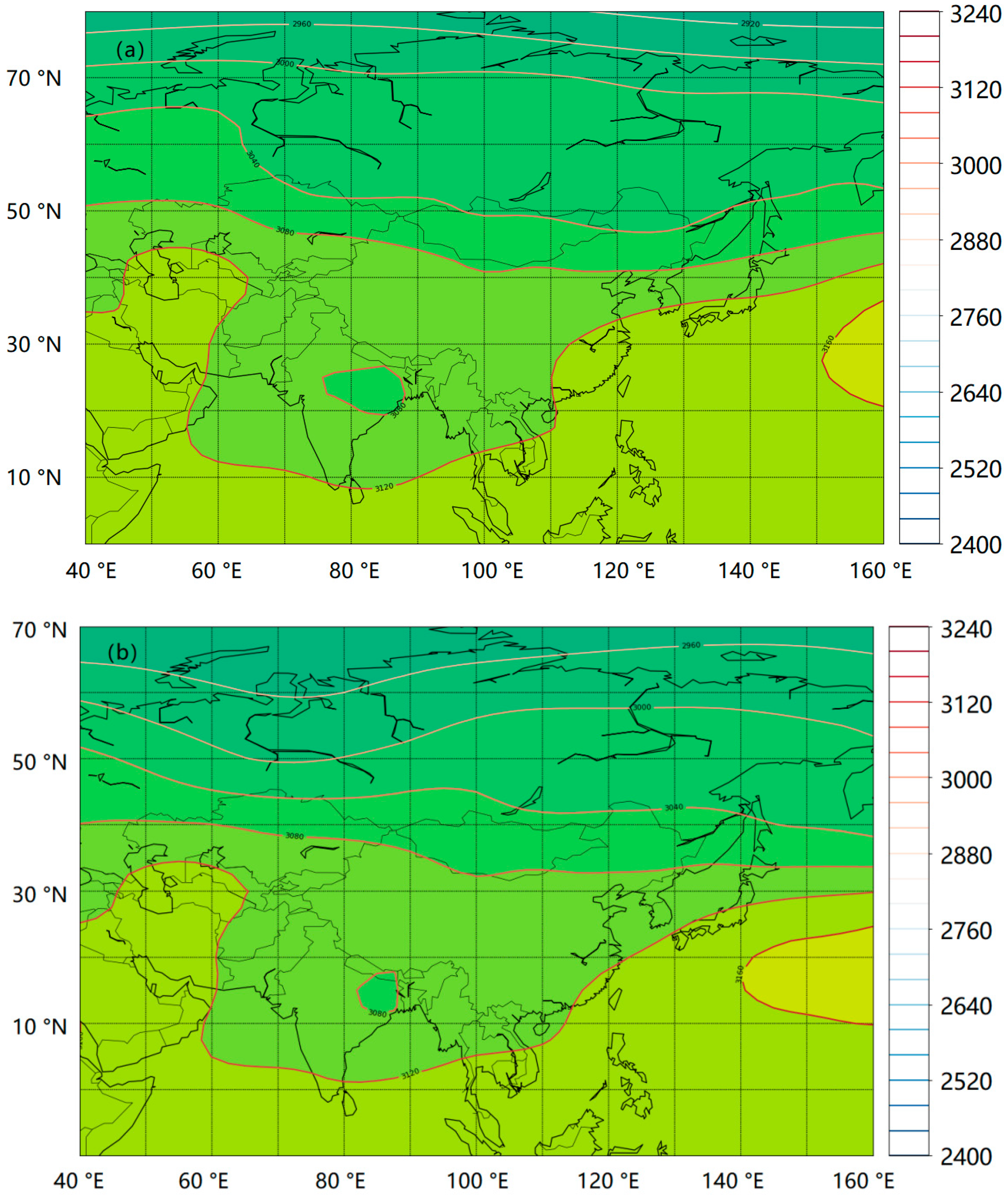
| Mutation Year | Slope (d/10a) | |
|---|---|---|
| 2009 | Premutation slope (Before 2009) | Post-mutation slope (After 2009) |
| 0.4 | 2.8 | |
| Mutation Year | Slope (d/10a) | |||
|---|---|---|---|---|
| Earliest year of mutation | Last year of mutation | mean year of mutation | Premutation slope (Before 2003) | Post-mutation slope (After 2003) |
| 1977 | 2009 | 2003 | 0.4 | 1.4 |
Publisher’s Note: MDPI stays neutral with regard to jurisdictional claims in published maps and institutional affiliations. |
© 2022 by the authors. Licensee MDPI, Basel, Switzerland. This article is an open access article distributed under the terms and conditions of the Creative Commons Attribution (CC BY) license (https://creativecommons.org/licenses/by/4.0/).
Share and Cite
Hu, J.; Zhan, M.; Zhan, L.; Xin, J. Spatiotemporal Variation and Circulation Characteristics of Extreme Maximum Temperature Events in East China (1961–2020). Atmosphere 2022, 13, 609. https://doi.org/10.3390/atmos13040609
Hu J, Zhan M, Zhan L, Xin J. Spatiotemporal Variation and Circulation Characteristics of Extreme Maximum Temperature Events in East China (1961–2020). Atmosphere. 2022; 13(4):609. https://doi.org/10.3390/atmos13040609
Chicago/Turabian StyleHu, Jufang, Mingjin Zhan, Longfei Zhan, and Jiajie Xin. 2022. "Spatiotemporal Variation and Circulation Characteristics of Extreme Maximum Temperature Events in East China (1961–2020)" Atmosphere 13, no. 4: 609. https://doi.org/10.3390/atmos13040609






